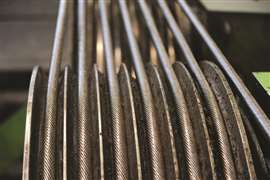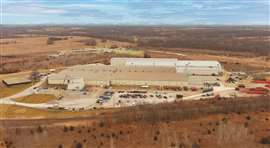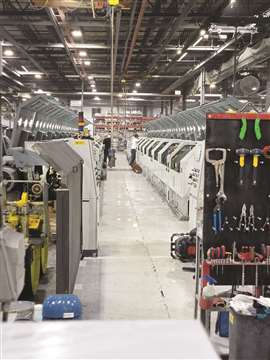How are wire rope manufacturers preparing for an infrastructure boom?
08 August 2023
Infrastructure became a noted focal point for the crane industry in the United States, even before the federal government passed the US$1 trillion Infrastructure Investment and Jobs Act (IIJA) in November 2021. With so many aging roads, bridges and support systems in need of critical upgrades, improvements or even flat-out replacements, questions were asked on how the private sector and government entities could come together and solve an extremely complex problem.
 Faster lead times means quicker change outs and less downtime for crane operators. When a crane rope reaches the end of its life cycle, crane operators want to have a replacement on hand. Downtime costs to a company can be as much as $200,000 per day in extreme cases.
Faster lead times means quicker change outs and less downtime for crane operators. When a crane rope reaches the end of its life cycle, crane operators want to have a replacement on hand. Downtime costs to a company can be as much as $200,000 per day in extreme cases.
The White House called the IIJA “a once-in-a-generation investment in our infrastructure,” and the legislation included “around $550 billion in new federal investment in America’s roads and bridges, water infrastructure, resilience, internet and more.”
“The Bipartisan Infrastructure Investment and Jobs Act will grow the economy, enhance our competitiveness, create good jobs and make our economy more sustainable, resilient and just,” a news release said.
Quick turnaround
With so many upgrade and replacement projects long overdue, leaders in the crane industry, including crane manufacturers (both in the U.S. and other countries), were prepared but faced a quick turnaround to respond to the needs in a market of opportunity. Suppliers, especially those in the steel wire rope industry, also felt the crunch.
Now that dollars are beginning to swirl, ramped-up demand that hasn’t been seen in many years, if ever, creates unique challenges. Beyond just the money earmarked by the government, there’s an entire subset of demands to support all the ancillary projects and equipment needed as the United States prepares to change the face of infrastructure in the country in what amounts to a mass modernization for roads, bridges, mass transit and more.
For manufacturers, users, operators and other key stakeholders associated with making a crane work on-site, this means preparing for the demands of continuous operation and strains on critical equipment. In most cases, this is a good problem to have, but with the likely uptick in crane usage, this means stress on crane rope will also come under scrutiny with the increased use. High-performance crane ropes will be put to the test, and with more strain comes more supply needed and the need to maximize lifespan of the product.
Crane rope manufacturers are left to navigate this environment, putting a priority on not just availability but also eliminating concerns related to quality and durability.
The expectation will be faster lead times to support the necessary usage increase but not at the cost of providing an inferior product. Faster lead times means quicker change outs and less downtime for crane operators. When a crane rope reaches the end of its life cycle, crane operators want to have a replacement on hand. Downtime costs to a company can be as much as $200,000 per day in extreme cases.
 WireCo invested $25 million to expand production capabilities in its Sedalia, MO.
WireCo invested $25 million to expand production capabilities in its Sedalia, MO.
Rope support
Therefore, the market must be able to supply trustworthy high-performance ropes, and operators aren’t willing to wait weeks or even days to receive the product when faced with an emergency replacement.
To ensure rope support is needed, manufacturers have made significant and noteworthy investments to support domestic production. For instance, WireCo quickly identified the need to change strategies on well-known and trusted brands Casar, Oliveira and Union. The company quickly made moves to support the great market opportunity by producing rotation-resistant rope designs in the United States, supplying even more high-performance crane ropes from a central location.
The company made its largest-ever capital investment to directly help support crane rope users. Over the past two years, WireCo has invested $30 million in new machines, technology, facility upgrades and processes (including rigorous internal and external quality testing programs) to support the infrastructure boom. This focus on the U.S. market was deliberate, responding to customers’ respect for and recognition of the company’s brands and products.
In particular, WireCo invested $25 million to expand production capabilities in its Sedalia, MO, facility, which provides a central location for distribution. The company currently employs more than 225 people in Sedalia, and this expansion will allow for job and economic growth while simultaneously helping to meet market demand and lead times required for crane operators as part of the infrastructure investment and focus resulting from the IIJA.
 Over the past two years, WireCo has invested $30 million in new machines, technology, facility upgrades and processes (including rigorous internal and external quality testing programs) to support the infrastructure boom.
Over the past two years, WireCo has invested $30 million in new machines, technology, facility upgrades and processes (including rigorous internal and external quality testing programs) to support the infrastructure boom.
“We believe strongly in the U.S. market and the infrastructure boom that is happening, both direct and indirect spend,” said Keith White, CEO of WireCo. “We know the industry will need ropes as soon as possible, and that operators want to go with brands they trust. By making this investment, we’ve significantly increased our output and capacity and, most importantly, our ability to meet lead times and demand for our most valued partners.”
Enhance processes
However, just simply writing a check and buying a machine does not suddenly mean all questions are answered in the manufacturing processes. The wire rope industry must also enhance processes, making sure to truly understand the most critical needs for customers and operators and keeping a close relationship with crane OEMs to account for the unique designs and capabilities of the new models currently being brought to the market.
The synergy of suppliers will remain critical as the long-term infrastructure investment plays out over the coming years, realizing that what works today might not be the preferred method for the duration.
Production facilities must have the ability to evolve and adapt as innovations in materials, coatings and manufacturing processes continue to alter the wire rope industry. Leaders continue to develop stronger, more durable products capable of functioning in harsh environments while maintaining wide usage across a variety of industries. This makes efficiency and soundness the true standard for the market.
“This is an 18-month process that we’ve been preparing for, from sourcing equipment to training employees,” said White. “Everyone is excited about the potential for our country and our manufacturers, but this requires a level of experience and expertise that doesn’t simply happen by ‘flipping a switch.’”
Operators seek out high-performance ropes for both their performance qualities, as the name suggests, and also their reliability, especially when utilized for very complicated and complex jobs. Not all ropes are made the same, which is why certain brands have come to be recognized over and over as the go-to ropes for the companies doing the most important lifts.
“If I’m designing a multimillion-dollar lift and thinking about all the factors that go into an effective operation, the last thing I want to worry about is the quality of my rope,” said Bulent Turan, chief growth officer of WireCo.
“Historically, many of the best-known crane ropes have been manufactured in Europe, including WireCo’s, but Made in the USA is an important criterion for WireCo and our customers. They trust that name,” added Turan.
Diversity and expansion
With so much funding available from the IIJA, diversity in the wire rope market will become even more imperative. According to the Global Steel Wire Rope Market Report and Forecast 2023-2028, the expansion of the construction, mining and maritime sectors is expected to increase the compound annual growth rate of 3.4 percent between 2023 and 2028.
With so much domestic growth anticipated, the status quo will no longer do, and customers will pass the stresses of the demand on to suppliers. The current response to increased domestic production clearly meets the immediate needs related to the IIJA, but also hopefully steers a new course for the industry and creates positive change and preparedness for wire rope supply in the United States.
“We’re proud of the fact we’re making crane rope that’s building the next generation of American infrastructure right here in the United States,” said White. “Our entire U.S. employee base – from manufacturing to corporate – has taken great pride in this investment, and it’s been wonderful to see it come to life … just in time.”

THE AUTHOR
Andreas Schmeiss is the global crane industry leader for WireCo World Group.
STAY CONNECTED


Receive the information you need when you need it through our world-leading magazines, newsletters and daily briefings.



